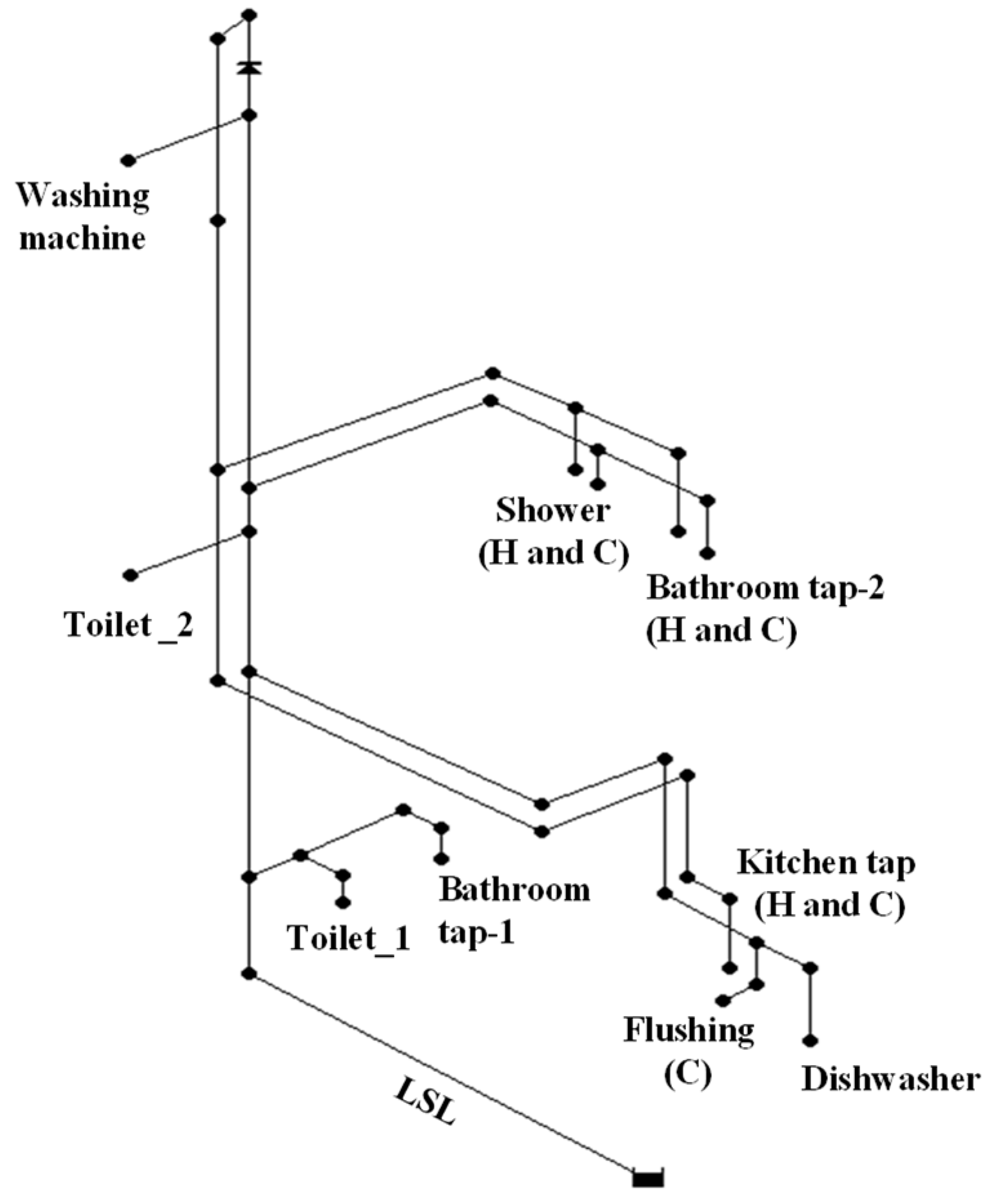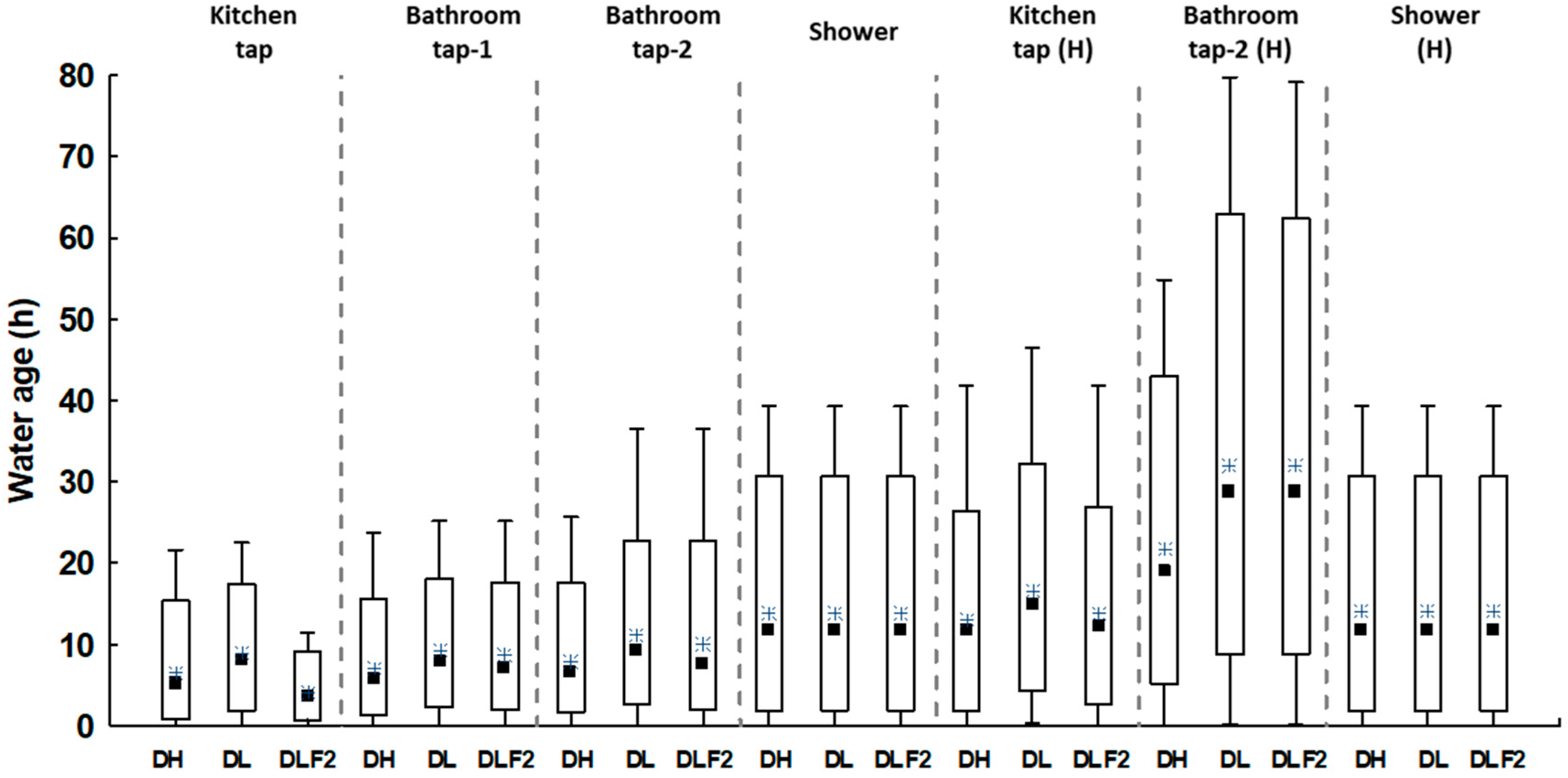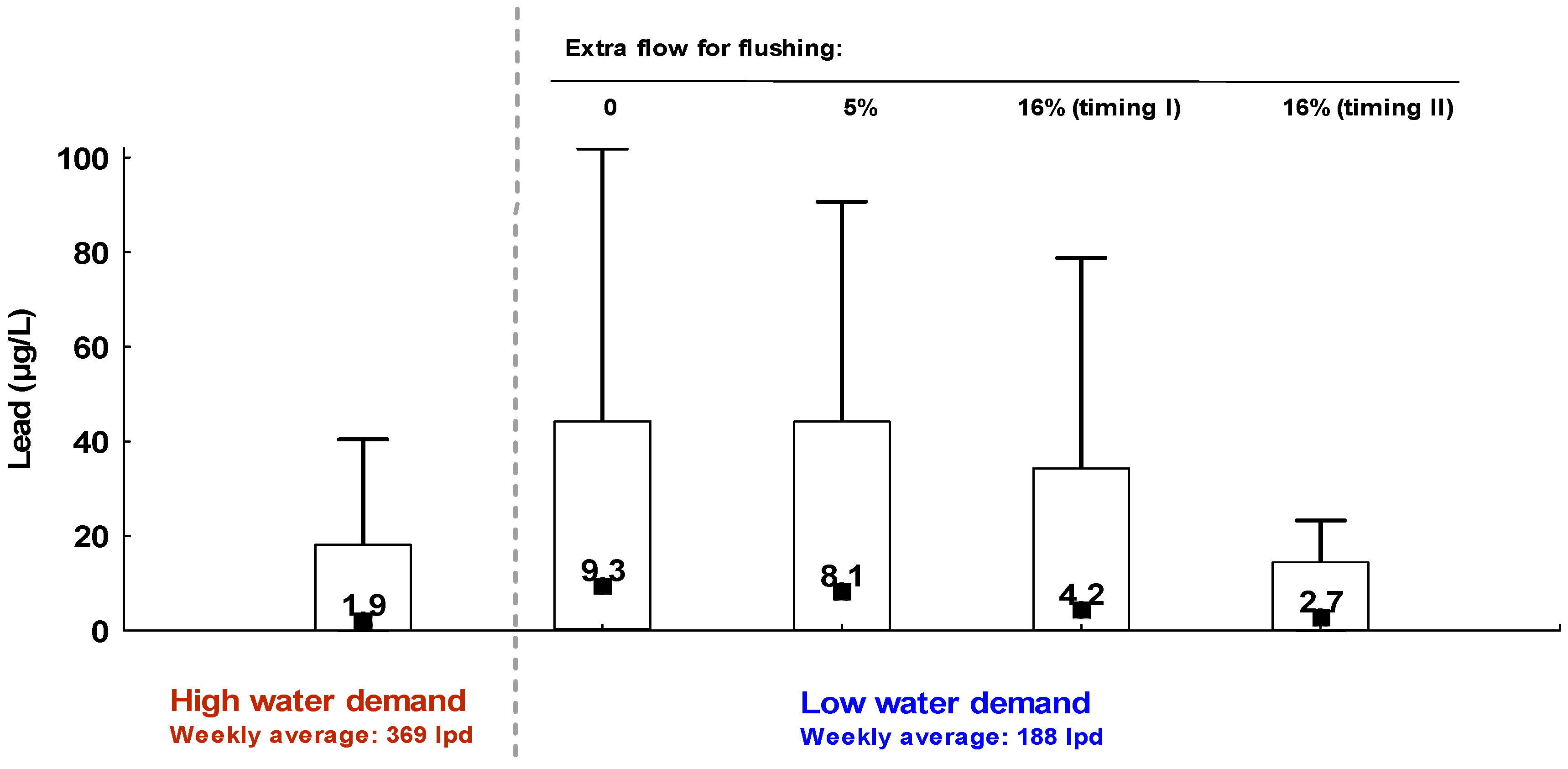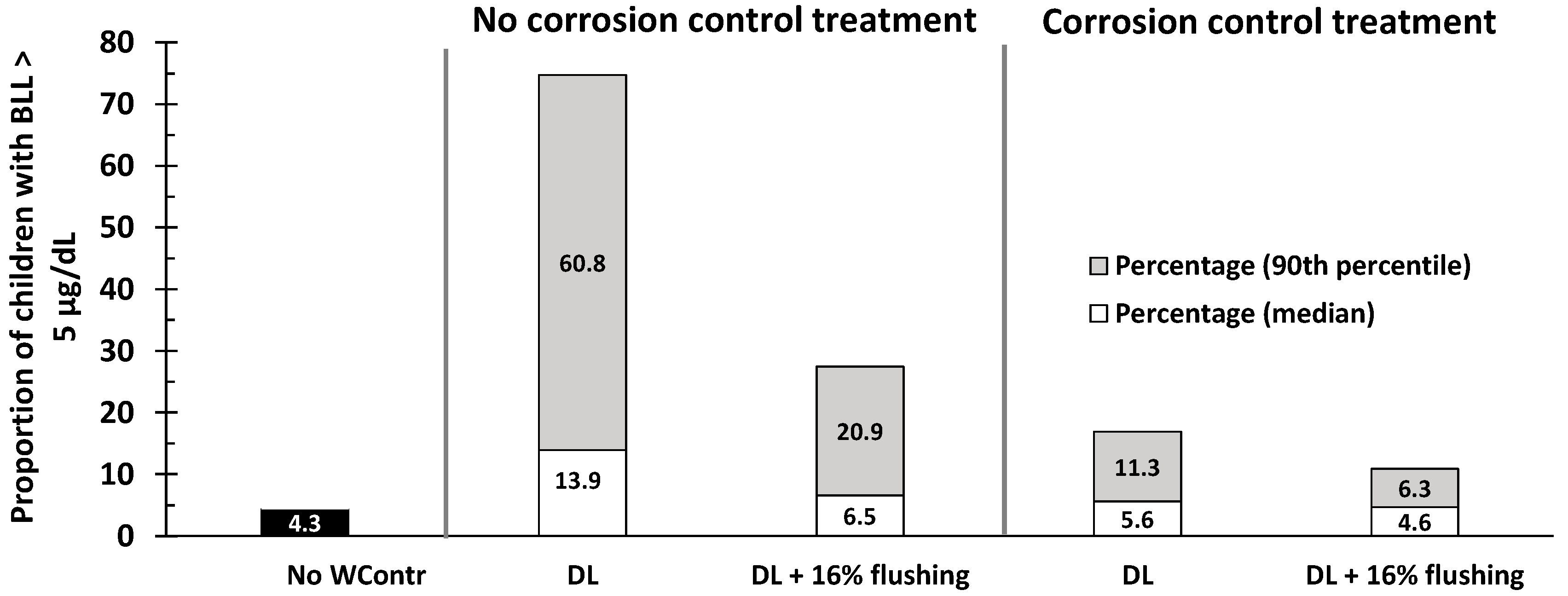Integrated Flushing and Corrosion Control Measures to Reduce Lead Exposure in Households with Lead Service Lines †
Abstract
1. Introduction
2. Materials and Methods
2.1. Plumbing Network Layout and Simulation Approach
2.2. Water Quality and Demand Scenarios with Flushing Strategies
3. Results and Discussion
3.1. Influence of Flushing and Conservation Measures on Water Age
3.2. Effects of Flushing Frequency and Timing on Lead Levels
3.3. Combined Effect of Flushing and Corrosion Control Measures
3.4. Potential Blood Lead Level Impact
3.5. Implications for Utilities
3.6. Limitations and Future Work
4. Conclusions
Author Contributions
Funding
Data Availability Statement
Acknowledgments
Conflicts of Interest
References
- Health Canada. Guidelines for Canadian Drinking Water Quality Guideline Technical Document. Lead; Government of Canada: Ottawa, ON, Canada, 2019; p. 113. [Google Scholar]
- Health Canada; Federal-Provincial-Territorial Committee on Drinking Water. Lead in Drinking Water; Health Canada: Ottawa, ON, Canada, 2017; p. 107. [Google Scholar]
- United States Environmental Protection Agency (USEPA). National Primary Drinking Water Regulations: Lead and Copper Rule Revisions, 2021; Federal Register: Washington, DC, USA, 2021; Volume 86.
- World Health Organization (WHO). Childhood Lead Poisoning; World Health Organization: Geneva, Switzerland, 2010; p. 74. [Google Scholar]
- Lanphear, B.P.; Hornung, R.; Khoury, J.; Yolton, K.; Baghurst, P.; Bellinger, D.C.; Canfield, R.L.; Dietrich, K.N.; Bornschein, R.; Greene, T.; et al. Low-level environmental lead exposure and children’s intellectual function: An international pooled analysis. Environ. Health Perspect. 2005, 113, 894–899. [Google Scholar] [CrossRef] [PubMed]
- Dettori, M.; Arghittu, A.; Deiana, G.; Castiglia, P.; Azara, A. The revised European Directive 2020/2184 on the quality of water intended for human consumption. A step forward in risk assessment, consumer safety and informative communication. Environ. Res. 2022, 209, 112773. [Google Scholar] [CrossRef]
- Elfland, C.; Scardina, P.; Edwards, M. Lead-contaminated water from brass plumbing devices in new buildings. J. Am. Water Work Assoc. 2010, 102, 66–76. [Google Scholar] [CrossRef]
- UNESCO; UN-Water. Water and Climate Change; UNESCO: Paris, France, 2020. [Google Scholar]
- Ministère du Développement durable, de l’Environnement et de la Lutte contre les changements climatiques (MDDELCC). 2018–2030 Québec Water Strategy; Communications Branch of MDDELCC: Québec, QC, Canada, 2018.
- United States Environmental Protection Agency (USEPA). WaterSence at Work. Best Management Practices for Commercial and Institutional Facilities; EPA 832-F-12-034; EPA WaterSence: Washington, DC, USA, 2012; p. 308.
- Proctor, C.; Rhoads, W.J.; Keane, T.; Salehi, M.; Hamilton, K.; Pieper, K.J.; Cwiertny, D.M.; Prévost, M.; Whelton, A. Considerations for large building water quality after extended stagnation. AWWA Water Sci. 2020, 2, e1186. [Google Scholar] [CrossRef]
- Salehi, M.; Odimayomi, T.; Ra, K.; Ley, C.; Julien, R.; Nejadhashemi, A.P.; Hernandez-Suarez, J.S.; Mitchell, J.; Shah, A.D.; Whelton, A. An investigation of spatial and temporal drinking water quality variation in green residential plumbing (sumbitted). Build. Environ. 2020, 169, 106566. [Google Scholar] [CrossRef]
- Hatam, F.; Ebacher, G.; Prévost, M. Stringency of water conservation determines drinking water quality trade-offs: Lessons learned from a full-scale water distribution system. Water 2021, 13, 2579. [Google Scholar] [CrossRef]
- Agudelo-Vera, C.; Blokker, M.; Vreeburg, J.; Vogelaar, H.; Hillegers, S.; van der Hoek Jan, P. Testing the robustness of two water distribution system layouts under changing drinking water demand. J. Water Resour. Plann. Manag. 2016, 142, 05016003. [Google Scholar] [CrossRef]
- Zhuang, J.; Sela, L. Impact of emerging water savings scenarios on performance of urban water networks. J. Water Resour. Plann. Manag. 2020, 146, 04019063. [Google Scholar] [CrossRef]
- Burkhardt, J.B.; Woo, H.; Mason, J.; Shang, F.; Triantafyllidou, S.; Schock Michael, R.; Lytle, D.; Murray, R. Framework for modeling lead in premise plumbing systems using EPANET. J. Water Resour. Plann. Manag. 2020, 146, 04020094. [Google Scholar] [CrossRef]
- Dash, A.; van Steen, J.; Blokker, M. Robustness of Profile Sampling in Detecting Dissolved Lead in Houshold Drinking Water. In Proceedings of the 2nd International Joint Conference on Water Distribution Systems Analysis & Computing and Control in the Water Industry, Valencia, Spain, 18–22 July 2022. [Google Scholar]
- Maheshwari, A.; Abokifa, A.A.; Biswas, P.; Gudi, R.D. Framework for evaluating the impact of water chemistry changes in full-scale drinking water distribution networks on lead concentrations at the tap. J. Environ. Eng. 2020, 146, 04020051. [Google Scholar] [CrossRef]
- Hatam, F.; Blokker, M.; Doré, E.; Prévost, M. Reduction in water consumption in premise plumbing systems: Impacts on lead concentration under different water qualities. Sci. Total Environ. 2023, 879, 162975. [Google Scholar] [CrossRef] [PubMed]
- Vizanko, B.; Kadinski, L.; Ostfeld, A.; Berglund, E.Z. Social distancing, water demand changes, and quality of drinking water during the COVID-19 pandemic. Sustain. Cities Soc. 2024, 102, 105210. [Google Scholar] [CrossRef]
- Burkhardt, J.B.; Minor, J.; Platten, W.E.; Shang, F.; Murray, R. Relative water age in premise plumbing systems using an agent-based modeling framework. J. Water Resour. Plann. Manag. 2023, 149, 04023007. [Google Scholar] [CrossRef] [PubMed]
- Clements, E.; Irwin, C.; Taflanidis, A.; Bibby, K.; Nerenberg, R. Impact of fixture purging on water age and excess water usage, considering stochastic water demands. Water Res. 2023, 245, 120643. [Google Scholar] [CrossRef]
- Lanphear, B.P.; Rauch, S.; Auinger, P.; Allen, R.W.; Hornung, R.W. Low-level lead exposure and mortality in US adults: A population-based cohort study. Lancet Public Health 2018, 3, e177–e184. [Google Scholar] [CrossRef]
- Lustberg, M.; Silbergeld, E. Blood lead levels and mortality. Arch. Intern. Med. 2002, 162, 2443–2449. [Google Scholar] [CrossRef] [PubMed]
- Ziegler, E.E.; Edwards, B.B.; Jensen, R.L.; Mahaffey, K.R.; Fomon, S.J. Absorption and retention of lead by infants. Pediatr. Res. 1978, 12, 29–34. [Google Scholar] [CrossRef]
- Manton, W.I.; Angle, C.R.; Stanek, K.L.; Reese, Y.R.; Kuehnemann, T.J. Acquisition and retention of lead by young children. Environ. Res. 2000, 82, 60–80. [Google Scholar] [CrossRef]
- Levallois, P.; St-Laurent, J.; Gauvin, D.; Courteau, M.; Prévost, M.; Campagna, C.; Lemieux, F.; Nour, S.; D’Amour, M.; Rasmussen, P.E. The impact of drinking water, indoor dust and paint on blood lead levels of children aged 1–5 years in Montreal (Québec, Canada). J. Expo. Sci. Environ. Epidemiol. 2013, 24, 185–191. [Google Scholar] [CrossRef]
- Deshommes, E.; Prévost, M.; Levallois, P.; Lemieux, F.; Nour, S. Application of lead monitoring results to predict 0–7 year old children’s exposure at the tap. Water Res. 2013, 7, 2409–2420. [Google Scholar] [CrossRef]
- Ngueta, G.; Prévost, M.; Deshommes, E.; Abdous, B.; Gauvin, D.; Levallois, P. Exposure of young children to household water lead in the Montreal area (Canada): The potential influence of winter-to-summer changes in water lead levels on children’s Blood lead concentration. Environ. Int. 2014, 73, 57–65. [Google Scholar] [CrossRef]
- Stanek, L.W.; Xue, J.; Lay, C.R.; Helm, E.C.; Schock, M.; Lytle, D.A.; Speth, T.F.; Zartarian, V.G. Modeled impacts of drinking water Pb reduction scenarios on children’s exposures and blood lead levels. Environ. Sci. Technol. 2020, 54, 9474–9482. [Google Scholar] [CrossRef]
- Moerman, A.; Blokker, M.; Vreeburg, J.; van der Hoek, J.P. Drinking Water Temperature Modelling in Domestic Systems. In Proceedings of the 16th Water Distribution System Analysis Conference, WDSA2014, Bari, Italy, 14–17 July 2014; pp. 143–150. [Google Scholar]
- Blokker, E.J.M.; Vreeburg, J.H.G.; van Dijk, J.C. Simulating residential water demand with a stochastic end-use model. J. Water Resour. Plan. Manag. ASCE 2010, 136, 19–26. [Google Scholar] [CrossRef]
- Hatam, F.; Blokker, E.; Prévost, M. Evaluation of flushing and corrosion control to lower lead levels at the taps in households with lead service lines. In Proceedings of the 19th Computing and Control for the Water Industry Conference (CCWI), Leicester, UK, 4–7 September 2023. [Google Scholar]
- Doré, E.; Deshommes, E.; Laroche, L.; Nour, S.; Prévost, M. Lead and copper release from full and partially replaced harvested lead service lines: Impact of stagnation time prior to sampling and water quality. Water Res. 2019, 150, 380–391. [Google Scholar] [CrossRef] [PubMed]
- Doré, E.; Deshommes, E.; Laroche, L.; Nour, S.; Prévost, M. Study of the long-term impacts of treatments on lead release from full and partially replaced harvested lead service lines. Water Res. 2019, 149, 566–577. [Google Scholar] [CrossRef]
- United States Environmental Protection Agency (USEPA). User’s Guide for the Integrated Exposure Uptake Biokinetic Model for Lead in Children (IEUBK); Version 2.0; United States Environmental Protection Agency: Washington, DC, USA, 2021.
- Deshommes, E.; Andrews, R.C.; Gagnon, G.; McCluskey, T.; McIlwain, B.; Dore, E.; Nour, S.; Prevost, M. Evaluation of exposure to lead from drinking water in large buildings. Water Res. 2016, 99, 46–55. [Google Scholar] [CrossRef]
- Doré, E.; Deshommes, E.; Andrews, R.C.; Nour, S.; Prévost, M. Sampling in schools and large institutional buildings: Implications for regulations, exposure and management of lead and copper. Water Res. 2018, 140, 110–122. [Google Scholar] [CrossRef]
- Keeley, S.; Dorevitch, S.; Kelly, W.; Jacobs, D.E.; Geiger, S.D. IEUBK Modeling of Children’s Blood Lead Levels in Homes Served by Private Domestic Wells in Three Illinois Counties. Int. J. Environ. Res. Public Health 2024, 21, 337. [Google Scholar] [CrossRef] [PubMed]
- Centers for Disease Control and Prevention (CDC). Response to Advisory Committee on Childhood Lead Poisoning Prevention Recommendations in “Low Level Lead Exposure Harms Children: A Renewed Call of Primary Prevention”; Centers for Disease Control and Prevention: Atlanta, GA, USA, 2012.
- Abokifa, A.A.; Biswas, P. Modeling soluble and particulate lead release into drinking water from full and partially replaced lead service lines. Environ. Sci. Technol. 2017, 51, 3318–3326. [Google Scholar] [CrossRef]





| Scenarios | Average Weekly Demand Per Household (lpd) | % of Increase |
|---|---|---|
| High demand (DH) | 368.9 | 96 |
| Low demand (DL) | 188.3 | 0 |
| Flushing once a day (DLF0) | 198.5 | 5 |
| Flushing three times a day (DLF1), (Timing I) | 218.6 | 16 |
| Flushing three times a day (DLF2), (Timing II) | 218.6 | 16 |
Disclaimer/Publisher’s Note: The statements, opinions and data contained in all publications are solely those of the individual author(s) and contributor(s) and not of MDPI and/or the editor(s). MDPI and/or the editor(s) disclaim responsibility for any injury to people or property resulting from any ideas, methods, instructions or products referred to in the content. |
© 2025 by the authors. Licensee MDPI, Basel, Switzerland. This article is an open access article distributed under the terms and conditions of the Creative Commons Attribution (CC BY) license (https://creativecommons.org/licenses/by/4.0/).
Share and Cite
Hatam, F.; Blokker, M.; Prevost, M. Integrated Flushing and Corrosion Control Measures to Reduce Lead Exposure in Households with Lead Service Lines. Water 2025, 17, 2297. https://doi.org/10.3390/w17152297
Hatam F, Blokker M, Prevost M. Integrated Flushing and Corrosion Control Measures to Reduce Lead Exposure in Households with Lead Service Lines. Water. 2025; 17(15):2297. https://doi.org/10.3390/w17152297
Chicago/Turabian StyleHatam, Fatemeh, Mirjam Blokker, and Michele Prevost. 2025. "Integrated Flushing and Corrosion Control Measures to Reduce Lead Exposure in Households with Lead Service Lines" Water 17, no. 15: 2297. https://doi.org/10.3390/w17152297
APA StyleHatam, F., Blokker, M., & Prevost, M. (2025). Integrated Flushing and Corrosion Control Measures to Reduce Lead Exposure in Households with Lead Service Lines. Water, 17(15), 2297. https://doi.org/10.3390/w17152297









